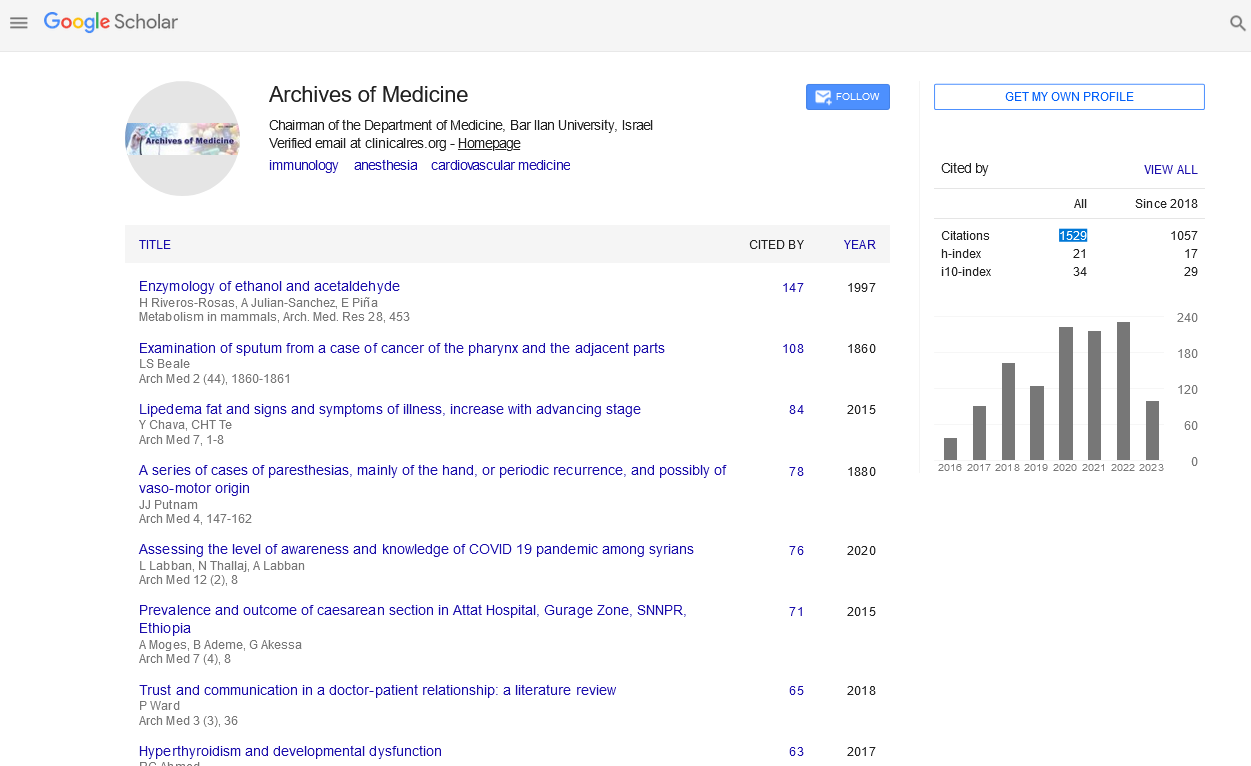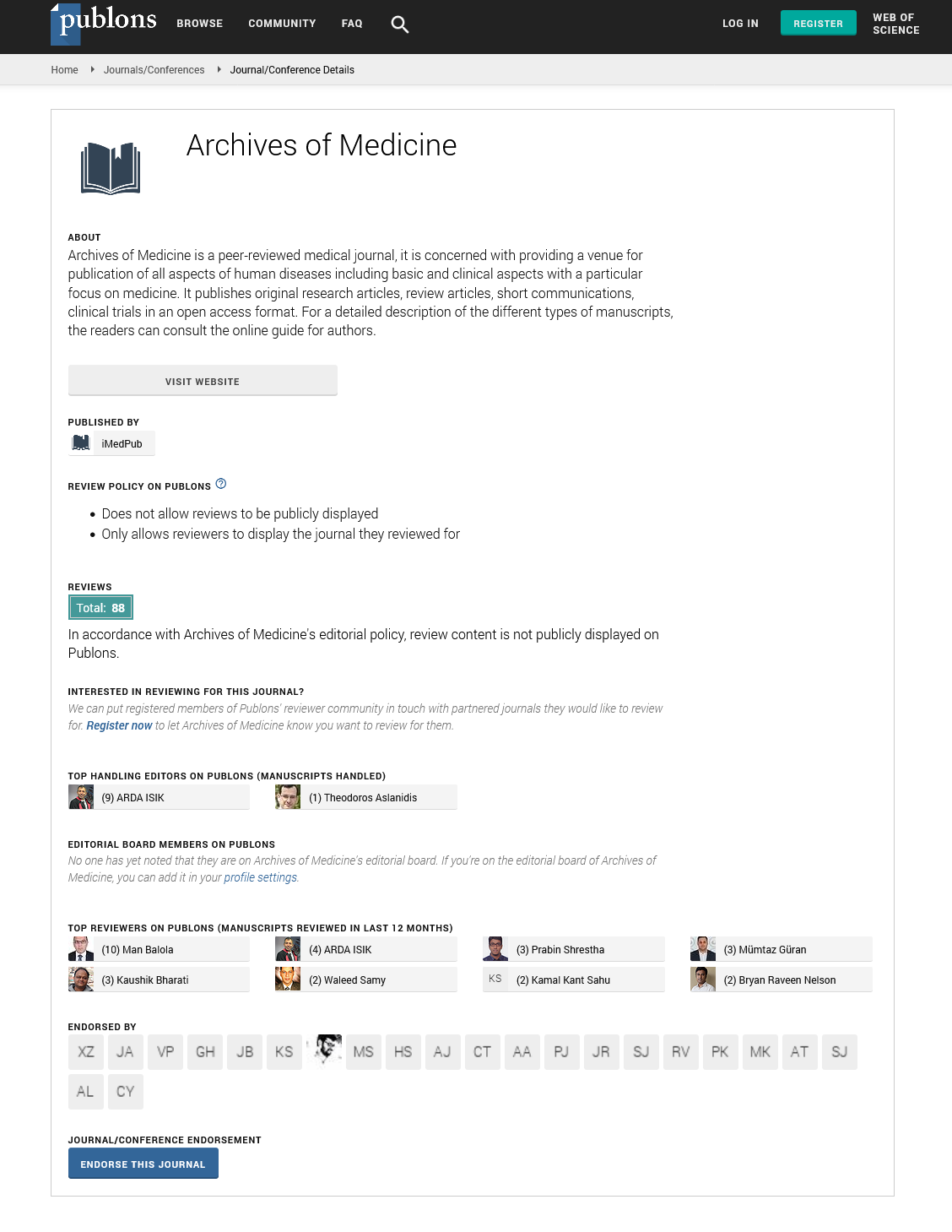Opinion - (2024) Volume 16, Issue 3
The art of detoxification: Principles and practices in toxicology and therapeutics
Alexander Alden*
Department of Health and Medical Sciences, Anglia Ruskin University, School of medicine, Cambridge, UK
*Correspondence:
Alexander Alden, Department of Health and Medical Sciences, Anglia Ruskin University, School of medicine, Cambridge,
UK,
Email:
Received: 01-May-2024, Manuscript No. ipaom-24-14996;
Editor assigned: 03-May-2024, Pre QC No. P-14996;
Reviewed: 15-May-2024, QC No. Q-14996;
Revised: 22-May-2024, Manuscript No. R-14996;
Published:
29-May-2024
Introduction
In the realm of modern medicine, the concept of detoxification holds a central place in the prevention and treatment of a wide array of health conditions. Rooted in ancient healing traditions and grounded in contemporary scientific principles, detoxification encompasses a diverse set of practices aimed at removing harmful substances from the body and restoring physiological balance. From traditional herbal remedies to cutting-edge medical interventions, the art of detoxification encompasses a rich tapestry of approaches that span cultures, disciplines, and historical epochs. This comprehensive exploration delves into the principles and practices of detoxification in toxicology and therapeutics, illuminating its multifaceted nature and enduring relevance in promoting health and well-being. The roots of detoxification can be traced back to ancient healing traditions practiced by civilizations across the globe. In ancient Egypt, Greece, India, and China, detoxification rituals formed an integral part of medical and spiritual practices, aimed at purifying the body, mind, and soul. Traditional systems of medicine, such as Ayurveda, Traditional Chinese Medicine (TCM), and Unani Tibb, developed elaborate detoxification protocols based on herbal remedies, dietary modifications, and cleansing rituals [1].
In ancient Greece, the concept of detoxification was closely linked to the teachings of Hippocrates, the father of Western medicine. Hippocratic physicians advocated for the use of fasting, herbal medicines, and hydrotherapy to cleanse the body of toxins and restore health. Similarly, in traditional Chinese medicine, the practice of "cleansing the body" (qing shu) was believed to promote longevity and vitality by eliminating excesses and restoring balance to the body's vital energy (qi).
During the Renaissance era, the study of toxicology began to emerge as a distinct scientific discipline, with scholars like Paracelsus laying the groundwork for modern toxicological principles. Paracelsus famously proclaimed that "the dose makes the poison," emphasizing the importance of understanding the relationship between dose, exposure, and toxicity. His revolutionary ideas challenged prevailing notions of toxicity and paved the way for advancements in detoxification therapies [2].
Description
The Industrial Revolution brought about unprecedented changes in society, accompanied by new challenges in toxicology and detoxification. The proliferation of industrial chemicals, environmental pollutants, and dietary toxins posed significant health risks to populations around the world. In response, scientists and physicians sought innovative approaches to detoxification, including the development of antidotes, chelating agents, and supportive care interventions.
Contemporary principles
In the modern era, the principles of detoxification in toxicology and therapeutics have evolved to encompass a holistic understanding of health and disease. Detoxification is no longer viewed as a one-time event but rather as an ongoing process of supporting the body's natural detoxification pathways and minimizing exposure to harmful substances. Key principles that guide contemporary detoxification practices include:
1. Supporting liver function: The liver plays a central role in detoxification by metabolizing and eliminating toxins from the body. Supporting liver function through dietary interventions, nutritional supplements, and lifestyle modifications is essential for optimizing detoxification pathways and promoting overall health.
2. Enhancing elimination: In addition to the liver, other organs and systems, such as the kidneys, lungs, skin, and gastrointestinal tract, play important roles in detoxification. Enhancing elimination pathways through hydration, exercise, sweating, and bowel regularity can facilitate the removal of toxins from the body.
3. Reducing toxic exposure: Minimizing exposure to environmental toxins, dietary contaminants, and lifestyle factors that contribute to toxic burden is a fundamental aspect of detoxification. Adopting organic, whole foods diets, using non-toxic household products, and avoiding excessive alcohol, tobacco, and drug use can help reduce toxic exposure and support detoxification efforts.
4. Promoting nutritional balance: Nutritional deficiencies can impair detoxification pathways and compromise overall health. Ensuring adequate intake of essential nutrients, including vitamins, minerals, antioxidants, and phytonutrients, is crucial for supporting detoxification and promoting cellular health.
5. Addressing emotional and spiritual factors: Detoxification is not just about physical cleansing but also involves addressing emotional, mental, and spiritual aspects of health. Practices such as meditation, mindfulness, stress reduction, and emotional processing can support detoxification by promoting relaxation, emotional resilience, and overall well-being [3].
Practices in toxicology and therapeutics
In the field of toxicology, detoxification practices encompass a range of interventions aimed at preventing, mitigating, and treating toxic exposures and poisoning emergencies. These practices may include:
1. Decontamination: Decontamination techniques, such as washing the skin or eyes with water, removing contaminated clothing, and administering activated charcoal or gastric lavage, are commonly used to reduce absorption and facilitate the elimination of toxic substances from the body.
2. Antidote therapy: Antidotes are specific agents that counteract the effects of toxic substances by neutralizing them, blocking their receptors, or enhancing their elimination. Examples of antidotes include naloxone for opioid overdose, atropine for organophosphate poisoning, and chelating agents for heavy metal toxicity.
3. Supportive care: Supportive care interventions, such as intravenous fluids, oxygen therapy, vasopressors, and mechanical ventilation, are essential for stabilizing patients with severe toxic exposures and preventing life-threatening complications.
4. Extracorporeal treatments: Extracorporeal treatments, including hemodialysis, hemoperfusion, and plasmapheresis, may be employed to enhance the removal of toxic substances from the bloodstream in cases of severe poisoning or overdose.
5. Environmental remediation: In addition to treating individual cases of poisoning, toxicologists also play a crucial role in identifying and mitigating environmental sources of toxicity. Environmental remediation efforts may involve soil and water testing, pollution monitoring, and regulatory interventions to reduce exposure to hazardous substances [4].
Therapeutic practices
In the realm of therapeutics, detoxification practices encompass a broader spectrum of interventions aimed at supporting the body's natural detoxification processes and promoting overall health and well-being. These practices may include:
1. Nutritional detoxification: Nutritional detoxification programs often involve dietary modifications, supplementation with vitamins, minerals, and antioxidants, and the use of herbal remedies and detoxifying foods to support liver function and enhance toxin elimination.
2. Hydrotherapy: Hydrotherapy, including techniques such as saunas, steam baths, hydrotherapy baths, and contrast showers, can promote detoxification by stimulating circulation, inducing sweating, and facilitating the elimination of toxins through the skin.
3. Colon cleansing: Colon cleansing techniques, such as enemas, colon hydrotherapy, and herbal laxatives, are sometimes used to remove impacted faecal matter, toxins, and waste products from the colon and promote bowel regularity.
4. Intravenous therapies: Intravenous (IV) therapies, such as IV vitamin infusions, chelation therapy, and glutathione injections, are administered directly into the bloodstream to bypass the digestive system and deliver nutrients and detoxifying agents directly to the cells.
5. Mind-Body practices: Mind-body practices, such as yoga, meditation, deep breathing exercises, and biofeedback, can support detoxification by reducing stress, promoting relaxation, and enhancing the body's natural healing mechanisms [5].
Emerging trends and future directions
As our understanding of detoxification continues to evolve, several emerging trends and future directions are shaping the landscape of detoxification in toxicology and therapeutics:
1. Personalized medicine: Advances in genomic medicine and precision health are paving the way for personalized approaches to detoxification that take into account individual genetic variations, metabolic profiles, and susceptibility factors.
2. Microbiome research: The gut microbiome plays a crucial role in detoxification and metabolic processes, influencing the body's ability to eliminate toxins and maintain health. Research into the gut-brain axis and microbiome-gut-liver axis is shedding light on the interconnections between gut health, detoxification, and overall well-being.
3. Environmental medicine: Environmental medicine focuses on the intersection of human health and environmental exposures, with an emphasis on identifying and mitigating environmental factors that contribute to toxic burden and chronic disease.
4. Integrative approaches: Integrative medicine combines conventional and complementary therapies to address the root causes of illness and promote holistic health. Integrative approaches to detoxification may involve combining conventional medical treatments with dietary and lifestyle interventions, herbal medicine, acupuncture, and mind-body practices.
5. Regenerative medicine: Regenerative medicine holds promise for harnessing the body's innate regenerative capacity to repair and regenerate damaged tissues and organs affected by toxic exposures. Stem cell therapies, tissue engineering, and regenerative treatments may offer new avenues for reversing the effects of toxic injury and restoring health.
Conclusion
The art of detoxification in toxicology and therapeutics represents a dynamic and evolving field that spans millennia of human history and encompasses a diverse array of practices, principles, and perspectives. From ancient healing traditions to modern scientific advancements, detoxification continues to play a vital role in promoting health, preventing disease, and enhancing quality of life. As we navigate the complexities of toxic exposures and environmental challenges in the 21st century, the art of detoxification remains a beacon of hope, offering pathways to healing, resilience, and vitality for individuals and communities around the world.
Acknowledgement
None.
Conflict of Interest
None.
References
- Grimaldi KA, van Ommen B, Ordovas JM, et al. Proposed guidelines to evaluate scientific validity and evidence for genotype-based dietary advice. Genes Nutr. 2017; 12:1-2.
Google Scholar, Crossref, Indexed at
- Bezuidenhout CC, Prinsloo M, Van der Walt AM. Multiplex PCR‐based detection of potential fumonisin‐producing Fusarium in traditional African vegetables. Int J Environ Toxicol. 2006; 21(4):360-366.
Google Scholar, Crossref, Indexed at
- Yiannikouris A, Poughon L, Cameleyre X, et al. A novel technique to evaluate interactions between Saccharomyces cerevisiae cell wall and mycotoxins: application to zearalenone. Biotechnol Lett. 2003; 25:783-789.
Google Scholar, Crossref, Indexed at
- Nathanail AV, Gibson B, Han L, et al. The lager yeast Saccharomyces pastorianus removes and transforms Fusarium trichothecene mycotoxins during fermentation of brewer’s wort. Food Chem. 2016; 203:448-455.
Google Scholar, Crossref, Indexed at
- Berry JP, Gantar M, Gibbs PD, et al. The zebrafish Danio rerio embryo as a model system for identification and characterization of developmental toxins from marine and freshwater microalgae. Com Biochem Physiol C Toxicol Pharmacol. 2007; 145(1):61-72.
Google Scholar, Crossref, Indexed at






